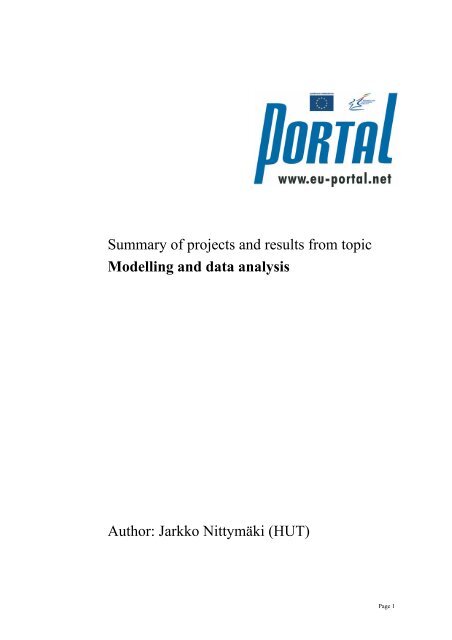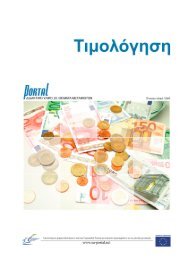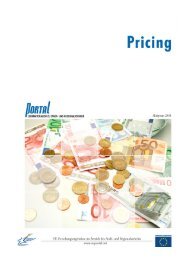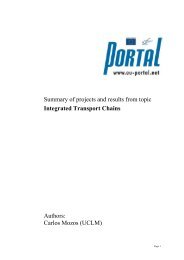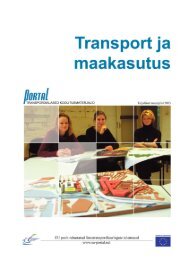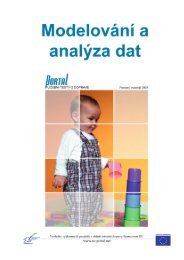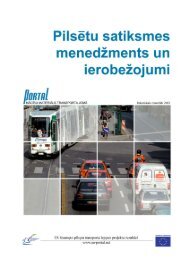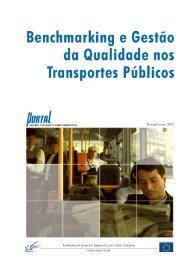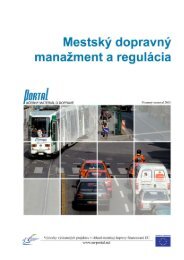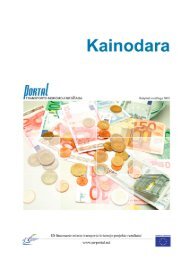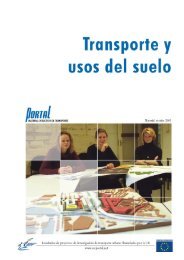view summary (pdf) - PORTAL - Promotion of results in Transport ...
view summary (pdf) - PORTAL - Promotion of results in Transport ...
view summary (pdf) - PORTAL - Promotion of results in Transport ...
You also want an ePaper? Increase the reach of your titles
YUMPU automatically turns print PDFs into web optimized ePapers that Google loves.
Summary <strong>of</strong> projects and <strong>results</strong> from topic<br />
Modell<strong>in</strong>g and data analysis<br />
Author: Jarkko Nittymäki (HUT)<br />
Page 1
Modell<strong>in</strong>g<br />
1. MODELLING AND DATA ANALYSIS ________________________ 5<br />
2. RECOMMENDATIONS FOR NEW MODULES _______________ 21<br />
3. FINAL CONCLUSIONS ____________________________________ 23<br />
Page 2
INTRODUCTION AND METHODOLOGY<br />
This report has been compiled by Hels<strong>in</strong>ki University <strong>of</strong> Technology to summarise<br />
the conclusions <strong>of</strong> the activities undertaken on the key topic Modell<strong>in</strong>g and data<br />
analysis as part <strong>of</strong> Work Package 2 <strong>of</strong> the <strong>PORTAL</strong> project.<br />
1.1 Methodology<br />
The ma<strong>in</strong> source used <strong>in</strong> gather<strong>in</strong>g <strong>in</strong>formation about modell<strong>in</strong>g and data analysis<br />
projects was the Internet. The search was started from the Internet sites conta<strong>in</strong><strong>in</strong>g<br />
<strong>summary</strong> <strong>in</strong>formation <strong>of</strong> transport related EU-projects, like CORDIS (Community<br />
Research and Development Information Service) and ELTIS (The European Local<br />
<strong>Transport</strong> Information Service).<br />
When the basic <strong>in</strong>formation and project participants were found, additional<br />
<strong>in</strong>formation was gathered and deepened by visit<strong>in</strong>g the project home pages (if they<br />
existed) and the home pages <strong>of</strong> project participants. In many cases, the Internet search<br />
services were useful.<br />
Other <strong>in</strong>formation sources were personal contacts with the project participants and<br />
project reports found <strong>in</strong> libraries. Inter<strong>view</strong>s were carried out by e-mail and phone<br />
calls.<br />
Problems encountered<br />
• Availability <strong>of</strong> sources:<br />
• Quite a lot <strong>in</strong>formation can be found <strong>in</strong> the Internet, but relevant and detailed<br />
<strong>in</strong>formation data are hard to f<strong>in</strong>d.<br />
• In many cases, co-ord<strong>in</strong>ators did not have any additional data compared to the<br />
web pages.<br />
• Sometimes unnecessary, <strong>in</strong>formation is presented <strong>in</strong> multiple sources.<br />
• Some project web sites have expired or malfunction.<br />
• Sometimes <strong>in</strong>formation on the Internet is only <strong>in</strong> the native language (not <strong>in</strong><br />
English) and can not be studied <strong>in</strong> all European countries.<br />
Contact-<strong>in</strong>formation:<br />
• In some cases, the right place for <strong>in</strong>formation is hard to f<strong>in</strong>d from the huge amount<br />
<strong>of</strong> data <strong>in</strong> Internet. This is due to the lack <strong>of</strong> proper contact <strong>in</strong>formation on the<br />
project web sites.<br />
• Only the most active project partners can be contacted easily.<br />
• In several cases (AIUTO, DIRECT), no <strong>in</strong>formation about the contact person <strong>of</strong><br />
expert partners or LEI’s could be found.<br />
• Because <strong>of</strong> the above-mentioned total lack <strong>of</strong> expert <strong>in</strong>formation and/or<br />
<strong>in</strong>sufficient partner <strong>in</strong>troduction, the specialities <strong>of</strong> each expert were hard to<br />
identify. This problem was encountered <strong>in</strong> almost all projects.<br />
• The same problem was encountered when specify<strong>in</strong>g the key topics <strong>of</strong> LEIs.<br />
Page 3
IPR-related problems:<br />
• Information on IPR does not exist or it is hard to <strong>in</strong>terpret.<br />
• Even the co-ord<strong>in</strong>ators do not necessary know the IPR status <strong>of</strong> their deliverables.<br />
Availability <strong>of</strong> <strong>in</strong>terest<strong>in</strong>g <strong>in</strong>formation:<br />
•<br />
•<br />
•<br />
•<br />
Most <strong>of</strong> the <strong>in</strong>troductions to<strong>of</strong> projects suffered from lack <strong>of</strong> clear lists <strong>of</strong><br />
<strong>in</strong>formation about project reports and deliverables. Only the existence and<br />
availability <strong>of</strong> f<strong>in</strong>al reports were clearly presented.<br />
Information was ma<strong>in</strong>ly <strong>in</strong> written form, and can not be reached easily.<br />
Due to the <strong>in</strong>sufficient <strong>in</strong>formation and availability <strong>of</strong> the project deliverables, it<br />
was hard to give any description <strong>of</strong> contents (keywords) about the deliverables<br />
found.<br />
There was a lack <strong>of</strong> proper descriptions <strong>of</strong> study sites and the <strong>results</strong> achieved <strong>in</strong><br />
pilot cases.<br />
Page 4
1. MODELLING AND DATA ANALYSIS<br />
1.1 Description <strong>of</strong> the key-topic Modell<strong>in</strong>g and<br />
data analysis<br />
The key-topic <strong>in</strong>cludes EU projects concern<strong>in</strong>g modell<strong>in</strong>g <strong>of</strong> all k<strong>in</strong>ds <strong>of</strong> traffic-related<br />
phenomenon, data gather<strong>in</strong>g <strong>of</strong> such phenomenon and systematic analysis <strong>of</strong> the<br />
gathered data. Modell<strong>in</strong>g <strong>of</strong> traffic relates closely to demand forecasts and operational<br />
analysis. Projects under this key-topic are <strong>of</strong>ten aimed at improv<strong>in</strong>g traffic plann<strong>in</strong>g<br />
and management at the strategic level, comb<strong>in</strong><strong>in</strong>g the ma<strong>in</strong> components affect<strong>in</strong>g<br />
traffic: land use, transport modes and environment.<br />
The Modell<strong>in</strong>g and data analysis key-topic discusses different modell<strong>in</strong>g methods<br />
(micro- and macro-level simulations, scenarios and other) and data analysis (statistical<br />
analysis <strong>of</strong> the basic data and the reliability <strong>of</strong> the model <strong>results</strong>).<br />
Subtopics <strong>of</strong> this key-topic are traffic management, simulation, telematics and<br />
environmental impacts. Thus, modell<strong>in</strong>g and data analysis –topic relates closely to the<br />
other <strong>PORTAL</strong> key-topics - 2 (Urban traffic management and restra<strong>in</strong>t), 5<br />
(Environment, energy and transport) and 9 (<strong>Transport</strong> Plann<strong>in</strong>g & Implementation).<br />
Projects that were allocated to the modell<strong>in</strong>g and data analysis are listed below.<br />
AIUTO: Models and methodologies for the assessment <strong>of</strong> <strong>in</strong>novative urban transport<br />
systems and policies options<br />
BRIDGES: Build<strong>in</strong>g Bridges between Digital <strong>Transport</strong> Databases, GIS Applications<br />
and <strong>Transport</strong> Models to Develop ETIS S<strong>of</strong>tware Structure<br />
DIRECT: Data <strong>in</strong>tegration requirements <strong>of</strong> European Cities for transport<br />
ESTEEM: European Scenarios on <strong>Transport</strong>-Energy-Environment for Metropolitan<br />
Areas<br />
FATIMA: F<strong>in</strong>ancial Assistance for <strong>Transport</strong> Integration <strong>in</strong> Metropolitan Areas<br />
MESUDEMO: Project concerned with methods for compil<strong>in</strong>g, stor<strong>in</strong>g, ma<strong>in</strong>ta<strong>in</strong><strong>in</strong>g<br />
and dissem<strong>in</strong>at<strong>in</strong>g <strong>in</strong>formation on transport networks and on flows <strong>of</strong> goods and <strong>of</strong><br />
passengers<br />
OPTIMA: Optimisation <strong>of</strong> policies for transport <strong>in</strong>tegration <strong>in</strong> metropolitan areas<br />
SCENES: Modell<strong>in</strong>g and Methodology for analys<strong>in</strong>g the <strong>in</strong>terrelationship between<br />
external developments and European transport<br />
SESAME: Derivation <strong>of</strong> the relationships between land use, behaviour patterns and<br />
travel demand for political and <strong>in</strong>vestment decisions<br />
STEMM: Development <strong>of</strong> strategic models for passenger and freight transport, which<br />
are spatially aggregated at the <strong>in</strong>tercity or <strong>in</strong>ter-prov<strong>in</strong>cial major corridor level<br />
STREAMS: Strategic transport research for European member states; Modell<strong>in</strong>g and<br />
Methodology for Analys<strong>in</strong>g the Interrelationships between External Developments<br />
and European <strong>Transport</strong><br />
Page 5
1.2 Results <strong>of</strong> project AIUTO<br />
The AIUTO project is aimed at identify<strong>in</strong>g new methodologies, methods and models<br />
to deal with <strong>in</strong>novative transport demand management (TDM) policies <strong>in</strong> urban<br />
contexts. Its concern is to provide an <strong>in</strong>sight <strong>of</strong> what methods have to be used when<br />
forecast<strong>in</strong>g the impacts <strong>of</strong> 's<strong>of</strong>t' transport policies, that is, transport measures that are<br />
reversible, flexible and that do not imply strong modification <strong>of</strong> exist<strong>in</strong>g<br />
<strong>in</strong>frastructures (e.g. park<strong>in</strong>g pric<strong>in</strong>g and management, road pric<strong>in</strong>g, pedestrianization,<br />
access control, etc.).<br />
The material <strong>in</strong>cludes sub reports and f<strong>in</strong>al report, which is available at CORDIS.<br />
The experts <strong>in</strong> the AIUTO project were CSST (Italy), SINTRA s.r.l (Italy), EURO<br />
TRANS CONSULTING LTD (UK), HAGUE CONSULTING GROUP B.V.<br />
(Netherlands) and Trias S.A. (Greece).<br />
Lead<strong>in</strong>g educational <strong>in</strong>stitutes <strong>in</strong> the AIUTO project were POLITECNICO DI<br />
MILANO (Italy), Facultés Universitaires Notre-Dame de la Paix (Belgium),<br />
Università degli Studi di Napoli "Federico II" (Italy), UNIVERSITY OF<br />
NEWCASTLE (UK), UNIVERSITY OF LEEDS (UK) and UNIVERSITY OF YORK<br />
(UK).<br />
Demo sites <strong>of</strong> AIUTO project were Como (IT), Salerno (IT), Randstad (NL), York<br />
(UK), Thessaloniki (GR) and Geneva (CH).<br />
Website <strong>of</strong> AIUTO project: www.cordis.lu/transport/src/aiuto.htm.<br />
Results <strong>of</strong> the project<br />
The AIUTO project has demonstrated that adequate modell<strong>in</strong>g capabilities to analyse<br />
TDM measures are generally available (<strong>in</strong> the form <strong>of</strong> disaggregat<strong>in</strong>g travel demand<br />
model systems and dynamic network assignment). However, from some site-<strong>results</strong> it<br />
appears evident that more validation tests would be useful for a better assessment <strong>of</strong><br />
the accuracy <strong>of</strong> such models.<br />
As part <strong>of</strong> this validation process, it would also be useful to conduct comprehensive<br />
sensitivity analyses to identify the most critical aspects and the key parameters <strong>of</strong> the<br />
models. However, the state <strong>of</strong> development <strong>of</strong> these tools is such that they are not yet<br />
readily available for wider dissem<strong>in</strong>ation or for quick policy analyses. In their exist<strong>in</strong>g<br />
state these capabilities require a long period <strong>of</strong> data collection and calibration, as well<br />
as heavy user <strong>in</strong>tervention and too much manual data-handl<strong>in</strong>g from sub-model to submodel.<br />
Thus, their application to a new study area would call for a major <strong>in</strong>vestment<br />
<strong>in</strong> terms <strong>of</strong> time, money and <strong>in</strong>volvement <strong>of</strong> highly skilled persons tra<strong>in</strong>ed and<br />
experienced <strong>in</strong> transportation demand and network modell<strong>in</strong>g.<br />
Materials<br />
F<strong>in</strong>al report<br />
•<br />
•<br />
•<br />
<strong>in</strong>cludes over<strong>view</strong> <strong>of</strong> the whole project<br />
available at CORDIS web site<br />
The f<strong>in</strong>al report is quite limited<br />
Demo site reports<br />
Page 6
• Available from project participants<br />
The available material is too limited to be used for educational purposes. For example<br />
<strong>in</strong> the f<strong>in</strong>al report, the modell<strong>in</strong>g methods are expla<strong>in</strong>ed <strong>in</strong> a rather general way , and<br />
no modell<strong>in</strong>g method can be studied deeply. On the other hand, the report emphasises<br />
local models, which makes the educational suitability <strong>of</strong> the material questionable<br />
even <strong>in</strong> general over<strong>view</strong> purposes.<br />
1.3 Results <strong>of</strong> the project BRIDGES<br />
The objective <strong>of</strong> the project BRIDGES is the development and implementation <strong>of</strong> the<br />
s<strong>of</strong>tware structure support<strong>in</strong>g the European <strong>Transport</strong> Information System (ETIS).<br />
This structure is understood as an open network <strong>of</strong> decentralised applications, where<br />
none <strong>of</strong> them becomes <strong>in</strong>dispensable. Therefore, l<strong>in</strong>ks between applications<br />
("bridges") are the crucial aspects <strong>of</strong> the research. The research followed these stages:<br />
- Assessment <strong>of</strong> future <strong>Transport</strong> Digital Data market trends: Creation <strong>of</strong> the <strong>Transport</strong><br />
Digital Data Sources Guide (DDG) - Development <strong>of</strong> an standard format for Data<br />
exchange between <strong>Transport</strong> Models (GTF) <strong>in</strong> the frame <strong>of</strong> ongo<strong>in</strong>g Models s<strong>of</strong>tware<br />
modernisation trends -Development <strong>of</strong> efficient l<strong>in</strong>ks and specialised <strong>in</strong>terfaces for<br />
expert-users (SIs) between common transport plann<strong>in</strong>g tools: <strong>Transport</strong> Models,<br />
Geographic Information Systems (GIS) and Database Managers.<br />
The material <strong>of</strong> the BRIDGES project <strong>in</strong>cludes s<strong>of</strong>tware packages, as well as an<br />
over<strong>view</strong> <strong>of</strong> the project and presentations.<br />
The experts <strong>of</strong> the BRIDGES project were Multicriteria Consult<strong>in</strong>g Ltd (Spa<strong>in</strong>),<br />
Marcial Echenique and Partners Ltd (UK), MKmetric Gesellschaft für Systemplnung<br />
Mbh (Germany) and <strong>Transport</strong>i e Territorio Srl (Italy)<br />
The lead<strong>in</strong>g educational <strong>in</strong>stitutes <strong>of</strong> the BRIDGES project were the National<br />
Technical University <strong>of</strong> Athens (Greece) and the Technical University <strong>of</strong> Denmark<br />
(Denmark)<br />
Demo site <strong>of</strong> the BRIDGES project is EC / DGVII<br />
Website <strong>of</strong> the BRIDGES project: www.transport.civil.ntua.gr/ECprojects/<br />
Bridges.hmtl<br />
Results <strong>of</strong> the project<br />
The ma<strong>in</strong> goals <strong>of</strong> he project BRIDGES were successfully achieved. The new data<br />
transfer protocols handled the l<strong>in</strong>kage <strong>of</strong> both alpha numeric and graphical data, and<br />
were able to evolve through time accord<strong>in</strong>g to the chang<strong>in</strong>g requirements <strong>of</strong> transport<br />
models. As a result, a significant part work was to look at recent advances <strong>in</strong> transport<br />
modell<strong>in</strong>g and consider how transport models were likely to change over the next few<br />
years. The form <strong>of</strong> the next generation <strong>of</strong> modell<strong>in</strong>g s<strong>of</strong>tware to meet these chang<strong>in</strong>g<br />
needs was also <strong>in</strong>vestigated. Demonstration workshops were carried out to present the<br />
progress <strong>in</strong> the ETIS system to potential users.<br />
Materials<br />
• Over<strong>view</strong> <strong>of</strong> the project is available at CORDIS web site and project home page<br />
Page 7
• S<strong>of</strong>tware packages (DSS, SI, CI) are available from EU/DGVII (Mr. Kiousis) or<br />
from NTUA<br />
The material <strong>in</strong>cludes technical data, like data transfer protocols, and it is not suitable<br />
for educational purposes. However, some important future guidel<strong>in</strong>es for traffic<br />
modell<strong>in</strong>g could be significant <strong>in</strong> education, and the technical reports could be edited<br />
to more comprehensive format.<br />
1.4 Results <strong>of</strong> the project DIRECT<br />
The <strong>in</strong>tegration <strong>of</strong> long/medium term plann<strong>in</strong>g and short-term traffic management<br />
procedures could both benefit through better data consistency, lower costs for data<br />
collection, improved quality and coverage <strong>of</strong> the data, better background for the<br />
development <strong>of</strong> new modell<strong>in</strong>g, prediction and analysis tools. The project DIRECT<br />
analyses the various aspects <strong>of</strong> the development, implementation and operation <strong>of</strong><br />
transport-data shar<strong>in</strong>g structures (TDSS) facilitat<strong>in</strong>g this <strong>in</strong>tegration. Not only the<br />
technological aspects are envisaged, but also the <strong>in</strong>stitutional, legal, organisational and<br />
f<strong>in</strong>ancial aspects.<br />
The Material <strong>of</strong> the DIRECT project <strong>in</strong>cludes f<strong>in</strong>al report, which is available <strong>in</strong> the<br />
project home page.<br />
The experts <strong>in</strong> the DIRECT project were Stratec S.A (Belgium), Centre D’Etudes sur<br />
les Réseaux, Les transports, L’Urbanisme et les Construction Publiques (France),<br />
Centre D’Etudes Techniques de L’Equipment Nord Picardie (France), Centre<br />
D’Etudes Techniques de L’Equipment de Lyon (France), Lille Métropole –<br />
Communaute Urba<strong>in</strong>e (France), Simulog S.A. (France), Azienda Tor<strong>in</strong>ese Mobilità<br />
(Italy), Netherlands Organisation for Applied Scientific Research (Netherlands) and<br />
Barcelona Technologia S.A. (Spa<strong>in</strong>).<br />
Lead<strong>in</strong>g educational <strong>in</strong>stitute <strong>in</strong> the DIRECT project was the University <strong>of</strong><br />
Southampton (UK)<br />
Demo sites <strong>of</strong> the DIRECT project were Barcelona (ES) and Lille (FR)<br />
Web page: www.<strong>in</strong>foservice.fr/simulog/direct/direct.html<br />
Results <strong>of</strong> the project<br />
The <strong>results</strong> <strong>of</strong> the project DIRECT conta<strong>in</strong> the follow<strong>in</strong>g topics:<br />
•<br />
•<br />
•<br />
•<br />
•<br />
The <strong>summary</strong> <strong>of</strong> DIRECT research and expected guidel<strong>in</strong>es for European cities.<br />
The classification <strong>of</strong> TDSS<br />
Development <strong>of</strong> guidel<strong>in</strong>es for design<strong>in</strong>g and implement<strong>in</strong>g any TDSS under the<br />
form <strong>of</strong> checklist<br />
General guidel<strong>in</strong>es for TDSS evaluation<br />
Evaluation <strong>of</strong> Barcelona and Lille DIRECT prototypes<br />
Page 8
Materials<br />
F<strong>in</strong>al report<br />
•<br />
•<br />
•<br />
•<br />
Includes an over<strong>view</strong> <strong>of</strong> the whole project<br />
Is available at the project home page<br />
conta<strong>in</strong>s experiences <strong>of</strong> TDSS use <strong>in</strong> many cities<br />
Demo site reports<br />
Summary available at project home page and more detailed <strong>in</strong>formation available<br />
from project participants<br />
The deliverables <strong>of</strong> DIRECT need some modification to be suitable for educational<br />
purposes, due to the fact that the <strong>results</strong> <strong>in</strong>clude ma<strong>in</strong>ly guidel<strong>in</strong>es on how to<br />
implement TDSS for organisations.<br />
1.5 Results <strong>of</strong> the project ESTEEM<br />
The purpose <strong>of</strong> ESTEEM is to adjust and validate <strong>in</strong>tegrated models <strong>of</strong> the<br />
<strong>in</strong>teractions between land-use, transport and environment and to apply it to four large<br />
European cities: Rome, Lyon, London and Brussels. The simulations will aim to<br />
assess the effects <strong>of</strong> land-use and/or transport policies on mobility and environment.<br />
The material <strong>in</strong>cludes f<strong>in</strong>al report and some prelim<strong>in</strong>ary and case reports. The f<strong>in</strong>al<br />
report is available on ISIS (Institute for System Integration Studies) ESTEEM web<br />
site.<br />
The experts <strong>in</strong> the ESTEEM project were Stratec (Belgium), Ove Arup and Partners<br />
(UK), CERTU (France), ISIS (Italy), Agence D'Urbanisme (France) and Royal<br />
Borough <strong>of</strong> Kens<strong>in</strong>gton and Chelsea (UK).<br />
Lead<strong>in</strong>g educational <strong>in</strong>stitutes <strong>in</strong> the ESTEEM project were ENEA (Italy) and<br />
Comune di Roma (Italy).<br />
Demo sites <strong>of</strong> ESTEEM project were Rome, Lyon, London and Brussels, where the<br />
use <strong>of</strong> modell<strong>in</strong>g and forecast<strong>in</strong>g tools was validated.<br />
Web site <strong>of</strong> ESTEEM project: ELTIS database (www.eltis.org/en/<strong>in</strong>dex.htm) and ISIS<br />
project home page (www.isis-it.com/Project/Esteem.htm).<br />
Results <strong>of</strong> the project<br />
The procedures and models developed with the ESTEEM study are now applicable to<br />
support public stakeholders <strong>of</strong> cities <strong>in</strong> the production <strong>of</strong> reliable estimates <strong>of</strong> impact<br />
<strong>of</strong> transport activities on energy and environment and <strong>in</strong> the identification <strong>of</strong> optimal<br />
policy options.<br />
The ESTEEM project has been tested out <strong>in</strong> practice <strong>in</strong> Brussels, London, Lyon and<br />
Rome us<strong>in</strong>g a number <strong>of</strong> different approaches. In order to appreciate them and decide<br />
which comb<strong>in</strong>ation <strong>of</strong> them can be used to better advantage <strong>in</strong> other cities, the project<br />
has produced a set <strong>of</strong> Guidel<strong>in</strong>es for Other Users. These illustrate, <strong>in</strong> simple terms,<br />
the choices available to urban decision-makers :<br />
Page 9
•<br />
•<br />
•<br />
•<br />
•<br />
•<br />
•<br />
build<strong>in</strong>g <strong>of</strong> urban scenarios, based on the modell<strong>in</strong>g and forecast <strong>of</strong> exogenous<br />
and policy factors <strong>in</strong>fluenc<strong>in</strong>g the demand <strong>of</strong> mobility, and <strong>in</strong>terfac<strong>in</strong>g them with<br />
transport models, the outputs <strong>of</strong> which are fed to emission/dispersion models.<br />
test<strong>in</strong>g land use and transport policies with an <strong>in</strong>tegrated <strong>in</strong>termodal land<br />
use/transport model, work<strong>in</strong>g with utility functions.<br />
exploit<strong>in</strong>g credible exogenous forecasts on land use and recurr<strong>in</strong>g <strong>in</strong> enhanced<br />
transport models and environmental dispersion/energy models <strong>in</strong> order to forecast<br />
energy consumption and pollutant emissions under various assumptions <strong>of</strong> local<br />
decisions on urban development.<br />
Materials<br />
F<strong>in</strong>al report<br />
<strong>in</strong>cludes comprehensive over<strong>view</strong> <strong>of</strong> the whole project<br />
available at on ISIS (Institute for System Integration Studies) ESTEEM web site<br />
<strong>in</strong>cludes also test site descriptions<br />
Demo site reports and other deliverables<br />
Available from ISIS.<br />
The study aimed ma<strong>in</strong>ly to support public stakeholders <strong>of</strong> cities <strong>in</strong> production <strong>of</strong><br />
reliable estimates <strong>of</strong> impact <strong>of</strong> transport activities, which does not provide suitable<br />
educational material. However, the f<strong>in</strong>al report <strong>in</strong>cludes chapters <strong>of</strong> general<br />
descriptions <strong>of</strong> different modell<strong>in</strong>g methods and previously used techniques, which<br />
can be <strong>in</strong>cluded <strong>in</strong> education.<br />
1.6 Results <strong>of</strong> project FATIMA<br />
The ma<strong>in</strong> aim <strong>of</strong> the FATIMA project is to identify the benefits <strong>of</strong> the optimal urban<br />
transport strategies to the private sector and the potential for obta<strong>in</strong><strong>in</strong>g private sector<br />
fund<strong>in</strong>g to reflect those benefits. It also determ<strong>in</strong>es the differences between strategies<br />
optimised us<strong>in</strong>g public funds and those optimised with<strong>in</strong> the constra<strong>in</strong>ts imposed by<br />
private fund<strong>in</strong>g <strong>in</strong>itiatives. With the <strong>results</strong> from the identification process it proposes<br />
mechanisms by which private sector fund<strong>in</strong>g can be provided appropriately while<br />
ma<strong>in</strong>ta<strong>in</strong><strong>in</strong>g the quality <strong>of</strong> operation and provides more general guidance on the role <strong>of</strong><br />
private sector fund<strong>in</strong>g for urban transport <strong>in</strong> EU.<br />
The material <strong>in</strong>cludes a f<strong>in</strong>al report and a lot <strong>of</strong> prelim<strong>in</strong>ary publications. The f<strong>in</strong>al<br />
report and a list <strong>of</strong> prelim<strong>in</strong>ary publications are available at the project home page.<br />
The experts <strong>in</strong> the FATIMA project were The Technical Research Centre <strong>of</strong> F<strong>in</strong>land<br />
(F<strong>in</strong>land), The Centre for the Study <strong>of</strong> <strong>Transport</strong> Systems (Italy), Azienda Tranvie<br />
Munizipale – Tor<strong>in</strong>o (Italy) and The Institute <strong>of</strong> <strong>Transport</strong> Economics (Norway).<br />
Lead<strong>in</strong>g educational <strong>in</strong>stitutes <strong>in</strong> the FATIMA project were the University <strong>of</strong> Leeds<br />
(UK) and the Technical University <strong>of</strong> Vienna (Austria).<br />
Page 10
Demo sites <strong>of</strong> FATIMA project were Ed<strong>in</strong>burgh and Merseyside (UK), Vienna and<br />
Eisenstadt (AT), Hels<strong>in</strong>ki (FI), Tor<strong>in</strong>o and Salerno (IT) and Tromo (NO)<br />
Website <strong>of</strong> FATIMA project: www.its.leeds.ac.uk/projects/fatima<br />
Results <strong>of</strong> the project<br />
The project adopted an approach, which <strong>in</strong>volved the application <strong>of</strong> the same study<br />
method to n<strong>in</strong>e cities, chosen to reflect a range <strong>of</strong> urban transport policy contexts <strong>in</strong><br />
Europe: Ed<strong>in</strong>burgh, Eisenstadt, Hels<strong>in</strong>ki, Merseyside, Oslo, Salerno, Tor<strong>in</strong>o, Tromsø<br />
and Vienna. This method <strong>in</strong>volved specify<strong>in</strong>g appropriate policy objective functions<br />
aga<strong>in</strong>st which transport strategies could be assessed, and f<strong>in</strong>d<strong>in</strong>g the specific strategy<br />
that optimised each <strong>of</strong> these functions. The objective functions covered a range <strong>of</strong><br />
differ<strong>in</strong>g regimes with respect to constra<strong>in</strong>ts on public f<strong>in</strong>ance and the <strong>in</strong>volvement <strong>of</strong><br />
the private sector.<br />
It was found that, <strong>in</strong> a majority <strong>of</strong> the case study cities, optimal socio-economic<br />
policies could be funded by road pric<strong>in</strong>g or <strong>in</strong>creased park<strong>in</strong>g charges, considered over<br />
a 30-year time horizon. Such measures would typically be used to make it feasible to<br />
<strong>in</strong>crease public transport frequency levels or decrease public transport fares. In general<br />
it was found to be important that the city transport plann<strong>in</strong>g authority had complete<br />
control over all transport measures, affect<strong>in</strong>g both private and public transport.<br />
However, such strategies are likely to require significant levels <strong>of</strong> <strong>in</strong>vestment and,<br />
given current attitudes towards constra<strong>in</strong>ts on public spend<strong>in</strong>g, it might be politically<br />
awkward for the public sector to raise such f<strong>in</strong>ance. There is,thus, a potentially useful<br />
role for private f<strong>in</strong>ance to be used to help overcome such (short-term) f<strong>in</strong>anc<strong>in</strong>g<br />
problems. However, it must be appreciated that the private sector will expect to make<br />
a pr<strong>of</strong>it on such <strong>in</strong>vestment. In cities where optimal policies are funded by travellers,<br />
the private sector can be reimbursed by travellers. In cities where it is not feasible for<br />
travellers to fund all the costs <strong>of</strong> optimal policies, it will be necessary for the private<br />
sector to be reimbursed from public funds (raised from taxes). An important issue here<br />
is that the use <strong>of</strong> private f<strong>in</strong>ance should not be allowed to replace optimal policies with<br />
sub-optimal policies.<br />
Materials<br />
F<strong>in</strong>al report<br />
•<br />
•<br />
•<br />
•<br />
Includes an over<strong>view</strong> and full <strong>results</strong> <strong>of</strong> the project<br />
Available at the project home page<br />
Other documents<br />
A list is available at the project home page<br />
Demo site reports<br />
Available from project participants<br />
The material is suitable for educational use as an example <strong>of</strong> one approach <strong>in</strong><br />
evaluat<strong>in</strong>g traffic policies. A more compact and general presentation might be more<br />
appropriate for course material.<br />
Page 11
1.7 Results <strong>of</strong> the project MESUDEMO<br />
The aim <strong>of</strong> the MESUDEMO project is to develop a methodology for creat<strong>in</strong>g a<br />
general European database on transport <strong>in</strong>frastructure and flows <strong>of</strong> passenger and<br />
goods. The methodology will address the establish<strong>in</strong>g <strong>of</strong> the framework <strong>of</strong> the<br />
database as well as supply<strong>in</strong>g a procedure for estimation <strong>of</strong> those variables which are<br />
urgently miss<strong>in</strong>g <strong>in</strong> a potential database. The database will cover the EEA +<br />
Switzerland, and take <strong>in</strong>to account a progressive <strong>in</strong>clusion <strong>of</strong> the CEEC/CIS countries.<br />
The material <strong>in</strong>cludes deliverables and f<strong>in</strong>al report, which are available at<br />
MESUDEMO Web server.<br />
The experts <strong>in</strong> the MESUDEMO project were AGDER Research Foundation<br />
(Norway), NEA <strong>Transport</strong> Research (Netherlands), ISTAT (Italy), National Technical<br />
University <strong>of</strong> Athens (Greece) and M<strong>in</strong>isterie van Verkeer en Waterstaat<br />
(Netherlands).<br />
Lead<strong>in</strong>g educational <strong>in</strong>stitute <strong>in</strong> the MESUDEMO project was National Technical<br />
University <strong>of</strong> Athens (Greece).<br />
Websites <strong>of</strong> MESUDEMO project: http://www.cordis.lu/transport/src/mesudemo.htm<br />
and http://www.telecom.ece.ntua.gr/mesudemo/<strong>in</strong>dex.html (MESUDEMO Web<br />
server).<br />
Results <strong>of</strong> the project<br />
In order to achieve an effective dissem<strong>in</strong>ation <strong>of</strong> the <strong>results</strong> <strong>of</strong> the work on the ETIS<br />
(European <strong>Transport</strong> Information System) overall and <strong>in</strong>ternal architecture, the<br />
work<strong>in</strong>g group <strong>of</strong> MESUDEMO have constructed a tool for the presentation <strong>of</strong> the<br />
new concepts, ideas and methodologies for the creation <strong>of</strong> an ETIS and the<br />
demonstration <strong>of</strong> the advantages <strong>of</strong> the novel po<strong>in</strong>ts <strong>of</strong> the proposed architecture.<br />
This tool is a Web-enabled environment, with a 3-tier, client-server architecture and<br />
advanced capabilities for handl<strong>in</strong>g geo-<strong>in</strong>formation through the Web. Web-based<br />
hypertext (html documents) will be used for the presentations, so that the users (i.e.<br />
the target audience for the dissem<strong>in</strong>ation and demonstration) will be able to<br />
concentrate on the po<strong>in</strong>ts <strong>of</strong> their <strong>in</strong>terest. Special clickable buttons <strong>in</strong> the Web<br />
documents will <strong>in</strong>itiate demonstration programs.<br />
Materials<br />
F<strong>in</strong>al report<br />
•<br />
•<br />
•<br />
summarises the ma<strong>in</strong> f<strong>in</strong>d<strong>in</strong>gs <strong>in</strong> the MESUDEMO project<br />
available at MESUDEMO Web server<br />
Deliverables<br />
available at MESUDEMO Web server<br />
The aim <strong>of</strong> the MESUDEMO project was to develop a methodology for creat<strong>in</strong>g a<br />
general European transportation database. As a specific technical study, the reports<br />
can ma<strong>in</strong>ly be used as examples <strong>in</strong> transportation courses.<br />
Page 12
1.8 Results <strong>of</strong> the project OPTIMA<br />
The overall objectives <strong>of</strong> Project OPTIMA (Optimisation <strong>of</strong> policies for transport<br />
<strong>in</strong>tegration <strong>in</strong> metropolitan areas) were:<br />
•<br />
•<br />
•<br />
•<br />
•<br />
•<br />
•<br />
•<br />
to identify optimal urban transport and land use strategies for a range <strong>of</strong> urban<br />
areas with<strong>in</strong> the EU<br />
to compare the strategies which are specified as optimal <strong>in</strong> different cities, and to<br />
assess the reasons for these differences<br />
to assess the acceptability and feasibility <strong>of</strong> implementation <strong>of</strong> these strategies<br />
both <strong>in</strong> n<strong>in</strong>e case study cities and more widely <strong>in</strong> the EU<br />
to use the <strong>results</strong> to provide more general guidance on urban transport policy<br />
with<strong>in</strong> the EU.<br />
The material <strong>in</strong>cludes<br />
Optimisation <strong>of</strong> policies for transport <strong>in</strong>tegration <strong>in</strong> metropolitan areas: Optima<br />
OPTIMA Consortium (1997a). Report on Work Package 10. ITS Work<strong>in</strong>g Paper<br />
No 498, Institute for <strong>Transport</strong> Studies, University <strong>of</strong> Leeds, England.<br />
OPTIMA Consortium (1997b). Report on Work Package 20. ITS Work<strong>in</strong>g Paper<br />
No 499, Institute for <strong>Transport</strong> Studies, University <strong>of</strong> Leeds, England.<br />
OPTIMA Consortium (1997c). Deliverable 2.<br />
The experts <strong>in</strong> the OPTIMA project were Anthony May and Paul M. Timms from<br />
The University <strong>of</strong> Leeds, Institute for <strong>Transport</strong> Studies, UK, Hermann Kn<strong>of</strong>lacher<br />
from The Technical University <strong>of</strong> Vienna, The Institute <strong>of</strong> <strong>Transport</strong> Plann<strong>in</strong>g and<br />
Traffic Eng<strong>in</strong>eer<strong>in</strong>g (TUW-IVV) ,Austria, Veli Himanen from The Technical<br />
Research Centre <strong>of</strong> F<strong>in</strong>land, VTT Communities and Infrastructure, F<strong>in</strong>land, Silvana<br />
T<strong>of</strong>folo from The Centre for the Study <strong>of</strong> <strong>Transport</strong> Systems (CSST), Italy, Enzo<br />
Corrado Bason from Azienda Tranvie Municipale - Tor<strong>in</strong>o (TT-ATM), Italy, and<br />
Harald M<strong>in</strong>ken from The Institute <strong>of</strong> <strong>Transport</strong> Economics (TØI), Norway.<br />
Lead<strong>in</strong>g educational <strong>in</strong>stitute <strong>in</strong> the OPTIMA project were The University <strong>of</strong> Leeds,<br />
Institute for <strong>Transport</strong> Studies and The Technical University Of Vienna,, Faculty <strong>of</strong><br />
Civil Eng<strong>in</strong>eer<strong>in</strong>g, Institute for <strong>Transport</strong> Plann<strong>in</strong>g and Traffic Eng<strong>in</strong>eer<strong>in</strong>g (TUW-<br />
IVV).<br />
Websites <strong>of</strong> OPTIMA project are: http://www.cordis.lu/transport/src/optima.htm<br />
(CORDIS project description page), http://www.cordis.lu/transport/src/optirep.htm<br />
(F<strong>in</strong>al Summary Report),<br />
http://europa.eu.<strong>in</strong>t/comm/transport/extra/res-optima.html (F<strong>in</strong>al Summary Report on<br />
<strong>Transport</strong>RTDProgrammeKnowledgeCentre),<br />
http://www.its.leeds.ac.uk/projects/optima/ (Project pages by the coord<strong>in</strong>at<strong>in</strong>g partner,<br />
<strong>in</strong>cl. Contact po<strong>in</strong>t, Objectives, Technical approach, Results and conclusions and<br />
Dissem<strong>in</strong>ation <strong>of</strong> <strong>results</strong>).<br />
Results <strong>of</strong> the project<br />
From the <strong>results</strong>, the follow<strong>in</strong>g recommendations can be made for policy makers<br />
Page 13
•<br />
•<br />
•<br />
•<br />
•<br />
•<br />
•<br />
•<br />
•<br />
•<br />
•<br />
•<br />
•<br />
•<br />
•<br />
strategies should be based on comb<strong>in</strong>ations <strong>of</strong> measures, and should draw fully on<br />
synergy between success measures;<br />
economically efficient measures can be expected to <strong>in</strong>clude low cost<br />
improvements to road capacity, improvements <strong>in</strong> public transport (<strong>in</strong>creased<br />
service levels or reductions <strong>in</strong> fares), and <strong>in</strong>creases <strong>in</strong> the cost <strong>of</strong> car use;<br />
public transport <strong>in</strong>frastructure <strong>in</strong>vestment is not likely, <strong>in</strong> the majority <strong>of</strong> cases, to<br />
be a element <strong>in</strong> economically efficient strategies;<br />
reductions <strong>in</strong> capacity to discourage car use are not likely to be economically<br />
efficient;<br />
the scale <strong>of</strong> changes <strong>in</strong> service levels and fares will be <strong>in</strong>fluenced by the current<br />
level <strong>of</strong> subsidy; <strong>in</strong> some cases a reduction <strong>in</strong> service levels or an <strong>in</strong>crease <strong>in</strong> fares<br />
may be on economic grounds;<br />
the scale <strong>of</strong> <strong>in</strong>crease <strong>in</strong> costs <strong>of</strong> car use will depend <strong>in</strong> part on current levels <strong>of</strong><br />
congestion; the study suggests that road pric<strong>in</strong>g and park<strong>in</strong>g charge <strong>in</strong>creases are<br />
<strong>in</strong>terchangeable, but this needs assess<strong>in</strong>g <strong>in</strong> more detail;<br />
<strong>in</strong> most cases economically efficient strategies can be designed which are<br />
f<strong>in</strong>ancially feasible, provided that revenues can be used to f<strong>in</strong>ance other strategy<br />
elements;<br />
the pursuit <strong>of</strong> susta<strong>in</strong>ability is likely to justify <strong>in</strong>vestment <strong>in</strong> public transport<br />
<strong>in</strong>frastructure, further improvements to public transport services and/or fares, and<br />
further <strong>in</strong>creases <strong>in</strong> the cost <strong>of</strong> car use;<br />
availability <strong>of</strong> f<strong>in</strong>ance will be a major barrier to implementation <strong>of</strong> many<br />
susta<strong>in</strong>ability-optimal strategies, and further work is needed to <strong>in</strong>vestigate the<br />
extent to which f<strong>in</strong>ancial costs can be reduced by strategies which are slightly suboptimal;<br />
legislation will be needed to enable implementation <strong>of</strong> road pric<strong>in</strong>g and to control<br />
park<strong>in</strong>g charges; <strong>in</strong> the UK and Italy there is also a case for chang<strong>in</strong>g legislation to<br />
permit economically more efficient public transport strategies;<br />
public acceptability will be a significant barrier with those measures which reduce<br />
service levels or <strong>in</strong>crease costs; this implies the need for effective public relations<br />
campaigns, and carefully designed implementation programmes;<br />
detailed measures to improve the environment and provide better facilities for<br />
cyclists, pedestrians and disabled people should be designed with<strong>in</strong> the context <strong>of</strong><br />
a preferred strategy.<br />
Methodological conclusions and recommendations<br />
the optimisation procedure has been shown to be successful, and has attracted<br />
widespread <strong>in</strong>terest; however, it is important that careful thought is given to the<br />
policy implications <strong>of</strong> each stage <strong>of</strong> the process;<br />
the frequent use <strong>of</strong> upper and lower bound values <strong>in</strong> the optima is a cause <strong>of</strong> some<br />
concern;<br />
strategic models are <strong>in</strong> many ways more appropriate than tactical models <strong>in</strong> the<br />
development <strong>of</strong> optimal strategies;<br />
Page 14
•<br />
•<br />
•<br />
•<br />
•<br />
•<br />
•<br />
such models should <strong>in</strong>clude walk<strong>in</strong>g and cycl<strong>in</strong>g, both peak and <strong>of</strong>f peak<br />
conditions, and the effects <strong>of</strong> public transport load<strong>in</strong>gs on user costs;<br />
Materials<br />
Optimisation <strong>of</strong> policies for transport <strong>in</strong>tegration <strong>in</strong> metropolitan areas: Optima<br />
OPTIMA Consortium (1997a). Report on Work Package 10. ITS Work<strong>in</strong>g Paper<br />
No 498, Institute for <strong>Transport</strong> Studies, University <strong>of</strong> Leeds, England.<br />
OPTIMA Consortium (1997b). Report on Work Package 20. ITS Work<strong>in</strong>g Paper<br />
No 499, Institute for <strong>Transport</strong> Studies, University <strong>of</strong> Leeds, England.<br />
Report on Work Packages 30 and 40<br />
Report on Work Package 50<br />
OPTIMA Consortium (1997c). Deliverable 2.<br />
1.9 Results <strong>of</strong> the project SCENES<br />
The SCENES project is based on the earlier 4th Framework Programme projects<br />
SCENARIOS and STREAMS. Work Area 10 embraces research work on drivers <strong>of</strong><br />
transport demand. The analyses <strong>of</strong> the SCENARIOS project are extended by<br />
<strong>in</strong>corporat<strong>in</strong>g research on demand/ supply <strong>in</strong>teraction, by exam<strong>in</strong><strong>in</strong>g regulatory<br />
systems applied <strong>in</strong> the transport sector, and by consider<strong>in</strong>g <strong>in</strong>stitutional aspects and<br />
studies on breaks <strong>in</strong> trends. In Work Area 11 the STREAMS Strategic <strong>Transport</strong><br />
Model <strong>of</strong> the EU is extended to Eastern Europe and enhanced. After its recalibration<br />
this model is validated as the SCENES European Forecast<strong>in</strong>g Model. Work<br />
Area 12 covers the issue <strong>of</strong> def<strong>in</strong><strong>in</strong>g transport demand scenarios for the EU for<br />
2020 and beyond. These scenarios are made up <strong>of</strong> external, socio-economic<br />
scenarios, and sets <strong>of</strong> policy scenarios.<br />
Material <strong>in</strong>cludes ten deliverables, <strong>in</strong> which six are available on the Internet at this<br />
moment. Deliverables can be downloaded from web site <strong>of</strong> The University <strong>of</strong><br />
Karlsruhe, Germany.<br />
The experts <strong>of</strong> SCENES project are ME&P Ltd. (UK), CSST (Italy), DLR<br />
(Germany), ISIS SA (France), LT Consultants Ltd. (F<strong>in</strong>land), Marcial Echenique y<br />
Compaña (Spa<strong>in</strong>), NEA (Netherlands), KTI (Hungary), NOBE (Poland), TIS<br />
(Portugal) and TRT (Italy).<br />
Lead<strong>in</strong>g educational <strong>in</strong>stitutes <strong>in</strong> the SCENES project are IWW (Germany),<br />
INRETS (France), ITS (UK), EPFL (Switzerland), NTUA (Greece), University <strong>of</strong><br />
Gdánsk (Poland), UPM (Spa<strong>in</strong>) and TNO Inro (Netherlands).<br />
Demo sites: The effects <strong>of</strong> deregulation on transport demand are analysed by<br />
examples for regional public passenger transport (Frankfurt, London, Lyon) and rail<br />
freight transport (Great Brita<strong>in</strong>, Germany, USA).<br />
Web sites <strong>of</strong> SCENES project are Scenes co-ord<strong>in</strong>ator homepages <strong>in</strong>clud<strong>in</strong>g<br />
participants and goals (fpiv.meap.co.uk/fpiv/SCENES.htm) and IWW (University <strong>of</strong><br />
Page 15
Karlsruhe) project pages <strong>in</strong>clud<strong>in</strong>g l<strong>in</strong>ks to all participants and deliverable downloads<br />
(www.iww.uni-karlsruhe.de:8002/SCENES).<br />
Results <strong>of</strong> the project<br />
The SCENES Internet Database has been established for the SCENES project <strong>in</strong><br />
order to provide a common platform for regional data. The access to the database<br />
system is password-protected. Access to the SCENES Internet Database is given to the<br />
European Commission and the partners <strong>in</strong>volved <strong>in</strong> the SCENES project. The<br />
SCENES Internet Database is a large assortment <strong>of</strong> regional data for nearly all<br />
countries <strong>in</strong> Europe. The SCENES Internet Database is an <strong>in</strong>formation pool for socioeconomic,<br />
technology, transport and tourism <strong>in</strong>dicators at regional level.<br />
All the ten deliverables are not yet available, thus the f<strong>in</strong>al <strong>results</strong> can not be<br />
presented. For example, the <strong>results</strong> <strong>of</strong> transport demand forecast<strong>in</strong>g model are not<br />
presented.<br />
Materials<br />
The deliverables are<br />
•<br />
•<br />
•<br />
•<br />
•<br />
•<br />
•<br />
•<br />
•<br />
•<br />
CEEC data and method (available from IWW’s SCENE project site)<br />
SCENES European transport forecast<strong>in</strong>g model specification (available)<br />
Drivers <strong>of</strong> <strong>Transport</strong> Demand- Western European Countries- (available)<br />
Drivers <strong>of</strong> <strong>Transport</strong> Demand- Central and Eastern European Countries (CEEC)-<br />
(available)<br />
SCENES European <strong>Transport</strong> Forecast<strong>in</strong>g Model and Appended Module:<br />
Technical Description<br />
External scenarios development (not available)<br />
An Information System for Regional Socio-Economic and <strong>Transport</strong> Demand-<br />
Influenc<strong>in</strong>g Factors: The SCENES Internet Database (available)<br />
SCENES transport forecast<strong>in</strong>g model <strong>results</strong> and regional model <strong>results</strong> (not<br />
available)<br />
Case studies on scenario development (not available)<br />
European scenarios: description <strong>of</strong> process and quantitative <strong>results</strong> (not available)<br />
The material seems to be exact and thorough. However , a simple <strong>summary</strong> <strong>of</strong> goals<br />
and achieved <strong>results</strong> are miss<strong>in</strong>g, at least at this moment.<br />
1.10 Results <strong>of</strong> the project SESAME<br />
The SESAME project aim is to def<strong>in</strong>e the relevant <strong>in</strong>dicators <strong>of</strong> transport, traffic,<br />
land-use and relevant externalities for transport/land-use plann<strong>in</strong>g and analyse the<br />
relationships between these <strong>in</strong>dicators <strong>in</strong> <strong>view</strong> <strong>of</strong> deriv<strong>in</strong>g a better understand<strong>in</strong>g <strong>of</strong> the<br />
Page 16
impacts <strong>of</strong> policies. Based on the <strong>in</strong>dicators and their relationships, it provides an<br />
operational framework for evaluat<strong>in</strong>g and effectively plann<strong>in</strong>g local policies.<br />
The material <strong>in</strong>cludes f<strong>in</strong>al report, which is available at CORDIS.<br />
The experts <strong>in</strong> the SESAME project were Centre D’Etudes sur les Réseaux, Les<br />
transports, L’Urbanisme et les Construction Publiques (France), Centre D’Etudes<br />
Techniques de L’Equipment Mediterranee (France), Barcelona Tecnologia S.A.<br />
(Spa<strong>in</strong>), Socialdata Institut für Verkehrs-und Infrastruktur-forschung GmbH<br />
(Germany), Netherlands Organisation for Applied Scientific Research (Netherlands),<br />
<strong>Transport</strong> Research Laboratory (UK), Peter Zeug<strong>in</strong> (Switzerland) and Systems<br />
Consultant (Switzerland).<br />
Demo Sites <strong>of</strong> SESAME project were Barcelona (ES), Lyon (FR) and London (UK).<br />
Website <strong>of</strong> SESAME project: www.arttic.com/projects/sesame.<br />
Results <strong>of</strong> the project<br />
One common hypothesis argues that public transport and non-motorised modes are<br />
competitors on the transport market, while the car has no real competition from public<br />
transport nor from non-motorised modes. The result obta<strong>in</strong>ed is contrary to this<br />
hypothesis. One can conclude that <strong>in</strong> urban areas the car has strong competition from<br />
the non-motorised modes and, especially <strong>in</strong> the central city <strong>of</strong> the local urban area,<br />
there are signs <strong>of</strong> some competition for the car from public transport. Little<br />
competition was found between non-motorised modes and public transport.<br />
Small cities have a larger car share while larger cities have a better ability to reduce<br />
the car share. This hypothesis is true to a certa<strong>in</strong> extent. The car share does decrease<br />
for cities <strong>of</strong> over 750 000 <strong>in</strong>habitants. For cities smaller than 750 000 <strong>in</strong>habitants there<br />
is a tendency towards a positive relationship between city size and car share. There is<br />
a positive correlation between the density <strong>of</strong> the local urban area and non-motorised<br />
mode share. Higher concentrations <strong>of</strong> <strong>in</strong>habitants and workplaces benefit to public<br />
transport as it <strong>in</strong>tensifies trip movements.<br />
Car ownership per household is strongly positively correlated with mode share. The<br />
more people have access to a car, the higher the car share <strong>in</strong> trips as well as <strong>in</strong><br />
kilometres travelled. As it is commonly stated <strong>in</strong> literature, car ownership rema<strong>in</strong>s one<br />
<strong>of</strong> the most important variables <strong>in</strong>fluenc<strong>in</strong>g the car share. About mode choice and time<br />
used for travel, the common hypotheses <strong>in</strong> the literature is that the time used for travel<br />
per day is constant and that mode choice changes will result <strong>in</strong> a change <strong>of</strong> trip<br />
distance rather than a change <strong>in</strong> the total time used for travel. These hypotheses are not<br />
proved by the data. The total time used for travell<strong>in</strong>g per day varies between 50 and 90<br />
m<strong>in</strong>utes and this difference is strongly dependent on the particular modal split <strong>of</strong> a<br />
city.<br />
The relationship between public transport supply and densities is well proven. The<br />
higher the density the higher the service level (measured <strong>in</strong> number <strong>of</strong> vehiclekilometres).<br />
Further analyses <strong>in</strong>dicate that the improvement <strong>of</strong> the service-level is the<br />
result <strong>of</strong> higher frequencies rather than a higher l<strong>in</strong>e-length.<br />
Cities or local urban areas that grew heavily <strong>in</strong> the last ten years have currently a low<br />
percentage <strong>of</strong> young and old people <strong>in</strong> the city and a high percentage <strong>of</strong> middle-aged<br />
people. Apparently cities grew because more middle aged people rema<strong>in</strong>ed liv<strong>in</strong>g <strong>in</strong><br />
the local urban area. The growth did not come from families with young<br />
people/children. Based on the experiences made <strong>in</strong> the project, <strong>in</strong> particular dur<strong>in</strong>g the<br />
Page 17
data analysis, a set <strong>of</strong> recommendations for politicians and planners has been worked<br />
out.<br />
Materials<br />
F<strong>in</strong>al report<br />
•<br />
•<br />
•<br />
<strong>in</strong>cludes over<strong>view</strong> <strong>of</strong> the project, <strong>results</strong> and conclusions and exploitation and<br />
dissem<strong>in</strong>ation plan<br />
available at CORDIS web site<br />
Demo site reports<br />
available from project participants<br />
The f<strong>in</strong>al report is quite narrow, and does not fit for educational use as it is.<br />
1.11 Results <strong>of</strong> the project STEMM<br />
The ma<strong>in</strong> objects <strong>of</strong> STEMM project are:<br />
• identify<strong>in</strong>g and quantify<strong>in</strong>g the factors affect<strong>in</strong>g modal split and route choice for<br />
passengers and freight,<br />
• develop<strong>in</strong>g methodology for modell<strong>in</strong>g <strong>in</strong>termodal cha<strong>in</strong>s for passenger and<br />
freight transport,<br />
• apply<strong>in</strong>g the developed methodologies to models represent<strong>in</strong>g mode and route<br />
choice for European networks and particular case studies,<br />
• exam<strong>in</strong><strong>in</strong>g barriers to <strong>in</strong>termodality aris<strong>in</strong>g from <strong>in</strong>stitutional and regulatory<br />
measures,<br />
• utilis<strong>in</strong>g these models to exam<strong>in</strong>e and test policy <strong>in</strong>struments for <strong>in</strong>creas<strong>in</strong>g the<br />
use <strong>of</strong> <strong>in</strong>termodal methods <strong>of</strong> transport and<br />
• prepar<strong>in</strong>g contributions to sem<strong>in</strong>ars at which <strong>results</strong> obta<strong>in</strong>ed from <strong>in</strong>vestigations<br />
<strong>of</strong> different types <strong>of</strong> policy <strong>in</strong>strument will be considered<br />
The material <strong>in</strong>cludes f<strong>in</strong>al report and is available at CORDIS.<br />
The experts <strong>in</strong> the STEMM project were Baxter Eadie Limited (UK), BETA. ULP<br />
(France), CERTE. UKC (UK), Coherence S.P.R.L (Belgium), DST.DETR (UK),<br />
ECOPLAN (Switzerland), ITS.UL (UK), IWW.UK (Germany), MDS Transmodal<br />
(UK), Mkmetric (Germany), SINTEF <strong>Transport</strong> Eng<strong>in</strong>eer<strong>in</strong>g (Norway), Technicatome<br />
(France) and VTT (F<strong>in</strong>land).<br />
Lead<strong>in</strong>g educational <strong>in</strong>stitutes <strong>in</strong> the STEMM project were Universite Louis Pasteur<br />
(France), The University <strong>of</strong> Kent at Canterbury (UK), The University <strong>of</strong> Leeds (UK),<br />
The University <strong>of</strong> Karlsruhe (Germany), Cork Regional Technical College (Ireland)<br />
and The Institute for <strong>Transport</strong> Economics (Germany).<br />
Page 18
Demo sites <strong>of</strong> the STEMM project were Transalp<strong>in</strong>e Traffic, Channel Tunnel, Scan-<br />
L<strong>in</strong>k Corridor, Nordic/North Sea Freight and Walloon Region/Pyrenees.<br />
Website <strong>of</strong> STEMM project: www.cordis.lu/transport/src/stemm.htm.<br />
Results <strong>of</strong> the project<br />
A sophisticated multi-country model <strong>of</strong> passenger transport has been developed, with<br />
<strong>in</strong>novative representation <strong>of</strong> non-l<strong>in</strong>ear modal choice, <strong>in</strong>tegrated multimodal networks,<br />
and estimation techniques tak<strong>in</strong>g account <strong>of</strong> variation and correlation <strong>in</strong> estimation<br />
precision. This model has been applied to the Trans-Alp<strong>in</strong>e region, and to the Scan-<br />
L<strong>in</strong>k Corridor.<br />
Two freight models have been developed and tested, both us<strong>in</strong>g similar conceptions <strong>of</strong><br />
factors affect<strong>in</strong>g mode and route choice. The <strong>results</strong> produced by the model at its<br />
current state <strong>of</strong> development are reliable, <strong>in</strong>tuitively sensible and consistent with other<br />
studies and also commercially plausible.<br />
Materials<br />
F<strong>in</strong>al report<br />
•<br />
•<br />
<strong>in</strong>cludes over<strong>view</strong> <strong>of</strong> the whole project<br />
available at CORDIS web site<br />
The f<strong>in</strong>al report is quite limited for educational purposes.<br />
1.12 Results <strong>of</strong> the project STREAMS<br />
The central objective <strong>of</strong> the STREAMS (Strategic transport research for European<br />
member states; Modell<strong>in</strong>g and Methodology for Analys<strong>in</strong>g the Interrelationships<br />
between External Developments and European <strong>Transport</strong>.) project was to build and<br />
implement a prototype model to (i) predict the demand for transport across the EU,<br />
and (ii) assign this demand to a set <strong>of</strong> networks represent<strong>in</strong>g transport supply <strong>in</strong> the<br />
EU. An <strong>in</strong>itial ‘Reference Scenario’ forecast for 2020 were also to be produced. In<br />
parallel with model development, there were objectives to research modell<strong>in</strong>g issues<br />
apply<strong>in</strong>g to the development <strong>of</strong> strategic models. An important element <strong>of</strong> this<br />
objective was the development <strong>of</strong> new s<strong>of</strong>tware products, designed to make the use <strong>of</strong><br />
large, strategic models more straightforward.<br />
The material <strong>in</strong>cludes Deliverables from 1 to 9, Marcial Echenique & Partners<br />
(2000), ‘Forecasts <strong>of</strong> EU/TEN-T transport and emissions: A pilot study’ – F<strong>in</strong>al<br />
Report, and F<strong>in</strong>al Report for Publication.<br />
The experts <strong>in</strong> the STREAMS project were John Lark<strong>in</strong>son and Scott Leitham from<br />
Marcial Echenique and Partners Limited, UK, Paavo Moilanen from Strafica Oy,<br />
F<strong>in</strong>land, Michael Wegener and Klaus Spiekermann from Universität Dortmund,<br />
Institut für Raumplanung, Germany, Angel Gil and Emilio Sanchez from Marcial<br />
Echenique y Compañía, S.A., Spa<strong>in</strong>, and Angelo Mart<strong>in</strong>o from TRT Trasporti e<br />
Territorio SrL, Italy.<br />
Page 19
Lead<strong>in</strong>g educational <strong>in</strong>stitute <strong>in</strong> the STREAMS project was Universität Dortmund,<br />
Institut für Raumplanung, Germany.<br />
Websites <strong>of</strong> STREAMS project are: www.cordis.lu/transport/src/streams.htm<br />
(CORDIS project description page), http://fpiv.meap.co.uk/fpiv/streams3.htm (Project<br />
homepage by the coord<strong>in</strong>at<strong>in</strong>g partner), http://www.trttrasportieterritorio.it/<br />
streams_eng.htm (Description <strong>of</strong> activities), http://europa.eu.<strong>in</strong>t/comm/transport/extra/<br />
f<strong>in</strong>al_reports/waterborne/STREAMS.<strong>pdf</strong> (F<strong>in</strong>al report for publication),<br />
http://fpiv.meap.co.uk/fpiv/Environ.htm (STREAMS extension: strategic<br />
environmental assessment pilot study).<br />
Results <strong>of</strong> the project<br />
A strategic prototype model to predict the demand for transport across the EU was<br />
built and implemented. The demand element <strong>of</strong> the model comprises <strong>in</strong>dependent<br />
passenger and freight components, s<strong>in</strong>ce they employ different methodologies. The<br />
model is well suited to test<strong>in</strong>g ‘demand’ scenarios <strong>in</strong> terms <strong>of</strong> their effects on the<br />
overall level <strong>of</strong> transport demand. Variations <strong>in</strong> population, employment and car<br />
availability on the passenger side, and production, and growth by sector on the freight<br />
side can be tested us<strong>in</strong>g the STREAMS model structure. Comb<strong>in</strong>ations <strong>of</strong> these<br />
‘demand’ and ‘transport policy’ scenarios can <strong>of</strong> course also be run.<br />
A strategic prototype model to assign the demand to a set <strong>of</strong> networks represent<strong>in</strong>g<br />
transport supply <strong>in</strong> the EU was built and implemented.<br />
The model should encapsulate all travel with<strong>in</strong> the EU, also short distance and slow<br />
mode trips. This called for a new approach to the treatment <strong>of</strong> ‘local’ (or <strong>in</strong>tra-zonal)<br />
trips, which account for the vast majority <strong>of</strong> trips made with<strong>in</strong> the EU, given the<br />
zon<strong>in</strong>g system. Us<strong>in</strong>g this system, it was possible to model more accurately the<br />
number <strong>of</strong> passenger trips with<strong>in</strong> certa<strong>in</strong> ‘distance bands’ by mode as a representation<br />
<strong>of</strong> ‘local’ trips. The model is therefore suitable for forecast<strong>in</strong>g aggregate transport<br />
statistics for the whole <strong>of</strong> the EU area, <strong>in</strong>clud<strong>in</strong>g as it does all trips (<strong>in</strong>clud<strong>in</strong>g short<br />
and walk trips).<br />
The 2020 Reference Scenario model run produced <strong>in</strong>terest<strong>in</strong>g key <strong>results</strong> for<br />
passenger and freight transport.<br />
The model was used to produce traffic forecasts by mode at the level <strong>of</strong> <strong>in</strong>dividual<br />
l<strong>in</strong>ks, for use <strong>in</strong> calculat<strong>in</strong>g various emissions data at the EU level associated with the<br />
TEN-T. This application <strong>of</strong> the model enabled valuable lessons to be learned, which<br />
are be<strong>in</strong>g applied <strong>in</strong> the development <strong>of</strong> the model with<strong>in</strong> the follow-on SCENES<br />
project<br />
•<br />
•<br />
•<br />
Materials<br />
Deliverables from 1 to 9: Most <strong>of</strong> these may be too complex for outsiders.<br />
Deliverable D8 / D10 – ‘STREAMS Model Structure and Results’ has received a<br />
wide circulation.<br />
Marcial Echenique & Partners (2000), ‘Forecasts <strong>of</strong> EU/TEN-T transport and<br />
emissions: A pilot study’ – F<strong>in</strong>al Report: useful <strong>in</strong> large strategic and policy<br />
approaches, presented to Commission policy <strong>of</strong>ficials<br />
F<strong>in</strong>al Report for Publication: over<strong>view</strong> <strong>of</strong> the whole project, available as <strong>pdf</strong>-file<br />
from the Internet, quite accessible<br />
Page 20
2. RECOMMENDATIONS FOR NEW<br />
MODULES<br />
The development <strong>of</strong> new modell<strong>in</strong>g and data analysis methods has been quite limited.<br />
The methods <strong>of</strong> studied projects have not been fully comprehensive, and quite few<br />
new methods have been properly <strong>in</strong>troduced. For example studies <strong>of</strong> new GISapplications<br />
were not widely presented.<br />
Data <strong>in</strong>tegration should be studied more carefully. Now the models were quite sitespecific<br />
(FATIMA, STEMM). The applicability <strong>of</strong> study <strong>results</strong> <strong>in</strong> general and more<br />
theoretical conclusions should be <strong>in</strong>cluded <strong>in</strong> the future studies. Some studies did<br />
consider the general use <strong>of</strong> data, but the level <strong>of</strong> sophistication was quite technical and<br />
perhaps too detailed for non-experts (BRIDGES, SCENES, MESUDEMO). In<br />
general, quite many projects and their reports emphasised technical development <strong>of</strong><br />
some specific method, which make the educational use <strong>of</strong> the study material quite<br />
difficult.<br />
Another study object that could have more weight is digital databases and especially<br />
the use <strong>of</strong> these databases. Digital maps and <strong>in</strong>formation systems (GIS, GPS) build on<br />
the top <strong>of</strong> database provide practical tools for research as well as several customer<br />
applications. For example MESUDEMO and SCENES handled specific transportation<br />
databases, but the practical applications, which are the most <strong>in</strong>terest<strong>in</strong>g issues from the<br />
educational po<strong>in</strong>t <strong>of</strong> <strong>view</strong>, were not clearly presented.<br />
The effective use <strong>of</strong> databases and models, and generalisation <strong>of</strong> data collection and<br />
use across Europe require flexible system architectures and standardisation. The<br />
simplest way to create at least some possibilities to transfer models and data collection<br />
studies to other geographical locations is to form a general approach to the modell<strong>in</strong>g<br />
problem. At first, the approach could be just an <strong>in</strong>struction for the model structure, and<br />
secondly, the effective and <strong>in</strong>ter-active solution <strong>of</strong> technical problems. As mentioned<br />
earlier, more a general approach might be more effective than site-specific modell<strong>in</strong>g.<br />
This level <strong>of</strong> sophistication was also one problem <strong>of</strong> our key topic when consider<strong>in</strong>g<br />
the educational use <strong>of</strong> study reports. No basic study or state <strong>of</strong> the art re<strong>view</strong> were<br />
available, and most <strong>of</strong> the material is too complicated to understand for non-experts.<br />
The subject is too narrow to be used <strong>in</strong> education European wide. The studies were<br />
<strong>of</strong>ten directed to city authorities (DIRECT, ESTEEM, OPTIMA) and focused on<br />
giv<strong>in</strong>g plann<strong>in</strong>g guidel<strong>in</strong>es. This k<strong>in</strong>d <strong>of</strong> focus does not provide very useful<br />
educational material without some edit<strong>in</strong>g <strong>of</strong> the material. The database and s<strong>of</strong>tware<br />
oriented studies, <strong>of</strong> which <strong>results</strong> <strong>in</strong>cluded database prototypes or s<strong>of</strong>tware products<br />
(MESUDEMO, BRIDGES), are also quite difficult to use <strong>in</strong> the education <strong>of</strong><br />
transportation eng<strong>in</strong>eer<strong>in</strong>g.<br />
In general, the project reports did not provide ready material for education. The<br />
quality and particularity <strong>of</strong> the reports were either too sophisticated and wide, or too<br />
poor. Some <strong>of</strong> the project <strong>results</strong>, however, can be used as examples and demo cases<br />
(FATIMA, MESUDEMO), or with some edit<strong>in</strong>g <strong>of</strong> the reports, even <strong>in</strong> larger scale<br />
(SCENES, ESTEEM).<br />
One scientific focus <strong>of</strong> future studies could be the more emphasis on the mathematical<br />
modell<strong>in</strong>g techniques and, especially, try<strong>in</strong>g to develop new methods. Artificial<br />
<strong>in</strong>telligence (AI) and rule based modell<strong>in</strong>g provide a simple approach to complicated<br />
Page 21
phenomenon modell<strong>in</strong>g. Sometimes it may be impossible to model the phenomenon<br />
strictly by theoretical formulas, and then us<strong>in</strong>g AI can be the only possibility to handle<br />
the problem. This is why new techniques, like fuzzy logic, neural networks and<br />
genetic algorithms, should have stronger weight <strong>in</strong> traffic modell<strong>in</strong>g research than they<br />
do nowadays.<br />
Page 22
3. FINAL CONCLUSIONS<br />
Different models are widely created and used, but some relevant issues are left outside<br />
the studies. The transferability and data record<strong>in</strong>g are sometimes neglected, which<br />
makes future studies harder to make, current studies harder to repeat and different<br />
models harder to compare to each other.<br />
The solution to the problems <strong>in</strong> transferability and comparability is clear model<br />
architecture, data standardisation and comprehensive report<strong>in</strong>g. Another problem <strong>in</strong><br />
research co-operation and learn<strong>in</strong>g from other studies is the lack <strong>of</strong> <strong>in</strong>formation about<br />
exist<strong>in</strong>g studies, or the availability <strong>of</strong> study reports. In addition to the technical<br />
standardisation, the (EU) study organisation structures, the research work completed<br />
and the report availability should be standardised or at least well <strong>in</strong>structed by the<br />
European Union. At the moment, the <strong>in</strong>formation <strong>of</strong> EU projects is hard to f<strong>in</strong>d and<br />
the report<strong>in</strong>g <strong>of</strong> study <strong>results</strong> varies a lot, which makes also the educational use <strong>of</strong><br />
study <strong>results</strong> very difficult.<br />
Other important future study objects <strong>in</strong> traffic and transportation modell<strong>in</strong>g are<br />
telematics and digital databases to support site-specific studies. After some general<br />
methods for modell<strong>in</strong>g are available, different databases provide data for the models.<br />
In addition to data collection <strong>of</strong> modell<strong>in</strong>g, telematic solutions can be used for traffic<br />
control and customer services.<br />
Focus<strong>in</strong>g only to the EU funded projects does not necessarily provide comprehensive<br />
picture <strong>of</strong> studies <strong>of</strong> traffic and transportation <strong>in</strong> Europe. One alternative could be<br />
emphasis<strong>in</strong>g the research work <strong>of</strong> Lead<strong>in</strong>g Educational Institutes (LEI’s), which may<br />
have many <strong>in</strong>terest<strong>in</strong>g projects that are not <strong>in</strong>cluded <strong>in</strong> the EU-project category. Some<br />
relevant data can be missed, if the projects <strong>of</strong> top research <strong>in</strong>stitutes are not <strong>in</strong> the<br />
project database. It should also be remembered, that traffic and transportation is<br />
studied all over the world. If only European studies are collected to databases,<br />
important data is left outside.<br />
Page 23


